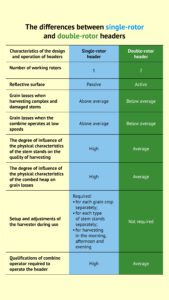Which is better, one or two rotors – this is one of the most pressing questions that agricultural producers face when choosing a stripper header.
This question is answered by Ph.D., Associate Professor of the Department of Optimization of Technological Systems at GBU, mr. Pakhuchiy.
Currently, the in-market stripper headers employ two structural designs: double-rotor and single-rotor.
The single-rotor design is represented by the Shelbourne and Ozon headers, the double-rotor arrangement is done in the Slavyanka stripper header.
Let’s take a look at the main features of the technological process of harvesting two types of stripper headers.
Harvesting, as the main useful function of the header, is realized in the stripper headers through two basic process operations: separation of caryopses from the ear and transportation of the stripped mass to the collector. Stripping is made by the stripper fingers while they are rotating together with the rotor.
The main feature of any stripper header is that part of thrashed heaps (free grains, ears, broken stems, chaff, glumes) fly ahead of the header’s travel after stripping, and, if not returned into the main stream, the whole grain mass will be lost. To prevent such losses, reflective devices are used in stripper headers, which are installed in front of the stripper beater, at some distance from it.
In the single-rotor header, the reflective device is the header’s passive internal surface of the front casing, along which a directed air flow is created by the stripping rotor. Bouncing off the passive surface, the cleaned particles slow down their movement, are picked up by the air flow and move into the auger. The effectiveness of such a process largely depends on the physical parameters (shape, moisture content, thickness, elasticity, structure) of the stripped particles, its mass, speed of hovering, aerodynamic properties and dynamic pressure of the air flow. If the kinetic energy of the air flow is not enough, then the grains and ears of corn are lost. It is for this reason that headers of this type provide for adjusting the rotation speed of the rotor and changing the position of the passive reflective surface (front casing).
In a double-rotor header,the function of returning the grain mass to the main stream is performed by the second rotor (blade behind beater).
Not only does it mechanically return (by rotation) the thrashed heaps into the main stream, but, jointly with the stripping rotor, it creates a powerful suction air flow. These two factors enable avoiding losses of the heaps flying ahead with different stem conditions, irrespective of the physical parameters (shape, moisture content, thickness, elasticity, structure) of the heaps themselves.
For harvesting of wet, differently high, poor-harvest and thinned cereals, or cereals with damaged stems, as well as when the combine harvester is operating at low speeds, for example, when harvesting lodged cereals and in a number of other cases, due to the differences considered, grain loss is always higher for a single-rotor header.
One more distinctive positive feature of the double-rotor header is the absence of necessity to configure and adjust the header in the operation process. All settings are done at the factory. Such circumstance facilitates the operation of the header and does not require a high qualification of a combine harvester operator.
The differences between single-rotor and double-rotor headers are presented in the table.

Important! Copying and using materials is allowed only if a reference to LLC “Ukr.Agro-service” is provided as the source of the information.